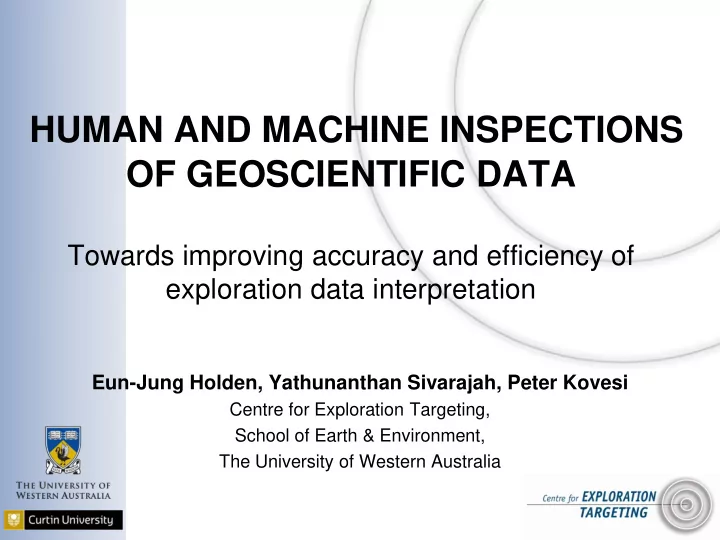

HUMAN AND MACHINE INSPECTIONS OF GEOSCIENTIFIC DATA Towards improving accuracy and efficiency of exploration data interpretation Eun-Jung Holden, Yathunanthan Sivarajah, Peter Kovesi Centre for Exploration Targeting, School of Earth & Environment, The University of Western Australia
BACKGROUND • Low exploration success rates & increasing need for challenging undercover exploration • To improve exploration success, we address the challenge of improving data interpretation, based on which exploration decisions are made. • Exploration data interpretation is a challenging task – Recognition & complex synthesis of patterns within single/multiple dataset – Subjective and inconsistent • Bond et al. (2007): seismic data interpretation accuracies (21% for tectonic setting detection; 23% for fault detection)
OUR STUDY 1. Can algorithm-based data inspection be used as ‘first - pass’ analysis to minimise the impact of human interpretation inconsistencies? Compare and analyse human and machine data inspections for porphyry detection task within magnetic data 2. Can we identify data display and interrogation methods that are effective for human interpretation? Examining human data interactions using quantitative monitoring of eye gaze and brain waves of interpreter
PORPHYRY DETECTION • Porphyry anomalies within magnetic data have specific shape characteristics • Abundance, shape variations, noisy surroundings etc 1 km Property of Barrick Gold Clark et al. (2008) AMIRA P700 Final Report
AUTOMATED METHOD • Supported by Barrick Gold • Automatically isolates magnetic anomalies that are likely to be Cu-Au porphyry systems SOFTWARE: CET Porphyry Analysis Extension (for Geosoft Oasis Montaj) http://www.geosoft.com/products/software-extensions/cet-porphyry-detection Developed within CET, licensed and marketed by Geosoft 1. Circular peak detection using Radial Symmetry Transform (Loy & Zelinsky, 2003) 2. Boundary enhancement using their amplitude contrast to the surrounding 1 km 3. Boundary tracing to provide approximate Property of Barrick Gold shape and size of the deposits Holden et al., 2011, Automatic identification of responses from porphyry intrusive systems within magnetic data using image analysis, Journal of Applied Geophysics, 74, pp.255-262
HUMAN INSPECTION • Five interpreters were asked to search for porphyry anomalies within a magnetic data (5 mins) • Eye tracker recorded the eye gaze pattern; Electroencephalography (EEG) profiled brain activities • Interpreters responded with a button click when spotting a target - the target locations identified using button click & eye gaze • Advantage : Eye tracking and EEG responses can be used for understanding of the interpretation process rather than just the outcome
EXPERIMENTS • Target detection from original display for 5 mins • Break (seismic interpretation, other EEG experiments) • Target detection from ‘180 degrees’ rotated display for 5 mins Property of Barrick Gold
HUMAN INSPECTION Original Image Inverted Image Combined Responses 0.90 0.80 0.70 Recall 0.60 0.50 0.40 0.30 1 2 3 4 5 Subject Number Recall = (No. of ground truth targets that are identified by the subject) / (No. of ground truth targets)
HUMAN INSPECTION at BEST (Human; Ground truth) Total number of targets G/T 21 Human 25 G/T & 18 Human Recall 86% Rate (18/21) False ? 7 Positives Recall = (No. of ground truth targets that are identified by the subject) / (No. of ground truth targets)
MACHINE INSPECTION (Machine; Ground truth) Total number of targets G/T 21 Machine 29 G/T & 16 Human Recall 76% Rate (16/21) False ? 13 Positives Human at Best Recall Rate: 86%
HUMAN vs MACHINE (Human at best; machine; ground truth) False ? Positives Human 7/25 Machine 13/29 Human & 6 Machine Human at Best Recall Rate: 86% Machine Recall Rate: 76%
DATA OBSERVATION PATTERNS Better performers have shorter path lengths between targets - more systematic search pattern
IMAGE CHACTERISTICS Target – Use of EEG target detection responses Non Target (ERP P300) to ERP P300 assess image characteristics that affect human target detection – Dispersion of visual attention over the image affects target detection
SUMMARY Human inspection has large variability amongst interpreters, and often inconsistent within individuals 1. Can algorithm- based data inspection be used as ‘first - pass’ to minimise human interpretation inconsistency? Machine inspection can provide the result almost equivalent to human at best, but consistently 2. Can we identify effective data display and interrogation methods for human interpretation? Methodical data search; viewing data in different angles Importance of scale in data display and enhancement assessed by localised visual attention
ACKNOWLEDGEMENTS • Barrick Gold for their research support for the porphyry detection project and the permission to use their data for the human data interaction study • Contributors: Mike Dentith, Roberto Togneri, Tele Tan, Greg Price, Jason Wong
Recommend
More recommend